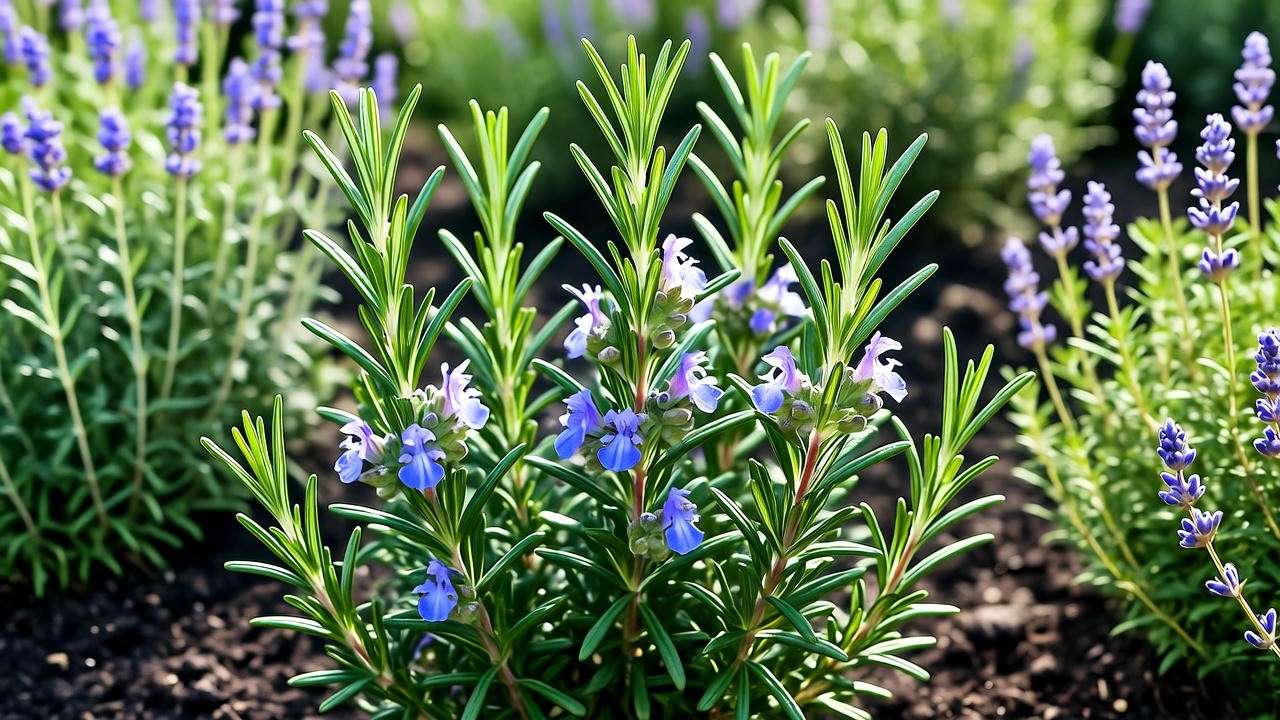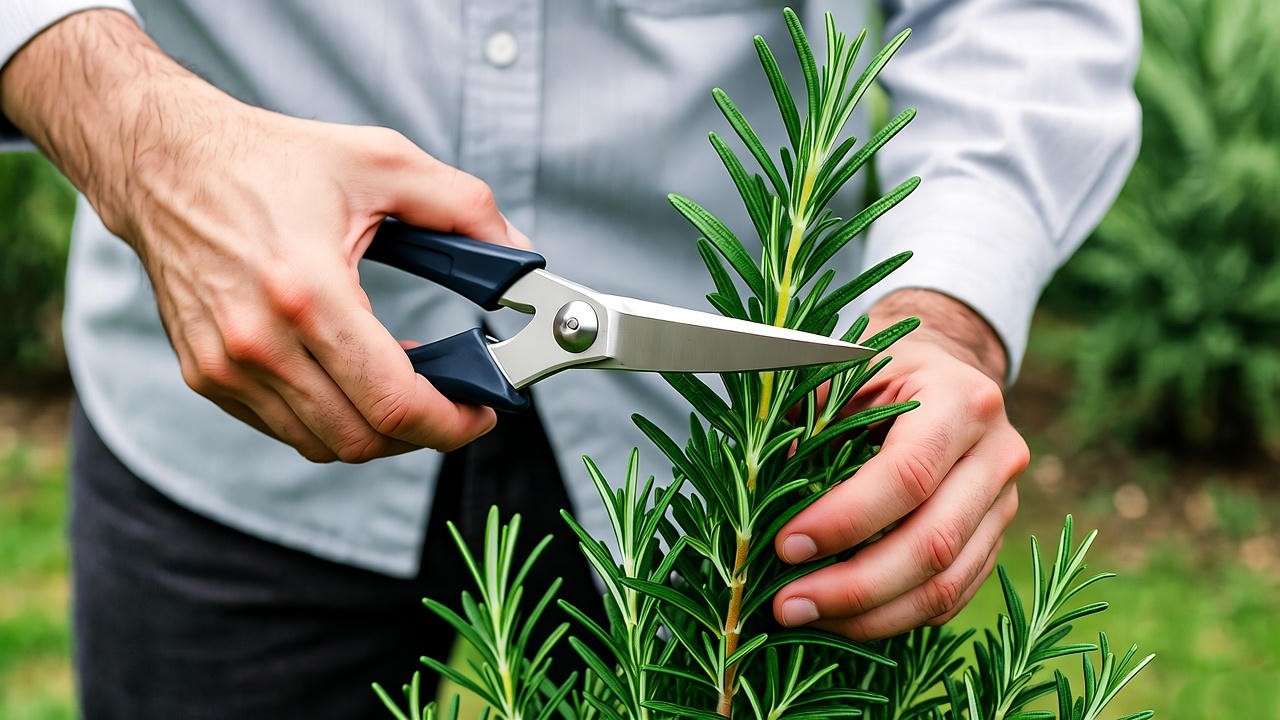Imagine stepping into your garden to snip fresh, fragrant sprigs from a thriving upright rosemary plant, ready to elevate your culinary creations or add charm to your landscape. Whether you’re a seasoned gardener or a beginner, growing an upright rosemary plant (Rosmarinus officinalis) is a rewarding journey that brings beauty, flavor, and resilience to your space. This aromatic, Mediterranean herb is beloved for its versatility, from culinary uses to ornamental appeal. In this comprehensive guide, we’ll share expert-backed strategies to help you cultivate a vibrant upright rosemary plant, addressing common challenges and unlocking its full potential. Backed by horticultural expertise and insights from trusted sources like the Royal Horticultural Society, this article offers everything you need to succeed. 🌞
1. Understanding the Upright Rosemary Plant 🌿
1.1 What Is an Upright Rosemary Plant? 🌱
Upright rosemary, scientifically known as Rosmarinus officinalis, is an evergreen shrub with woody stems, needle-like leaves, and a distinctive pine-like aroma. Unlike its prostrate or creeping cousins, upright rosemary grows vertically, reaching heights of 3–5 feet, making it ideal for hedges, garden borders, or container displays. Popular varieties like ‘Tuscan Blue,’ ‘Arp,’ and ‘Miss Jessopp’s Upright’ offer subtle differences in flavor, hardiness, and growth habits. Native to the Mediterranean, this herb thrives in sunny, well-drained environments, adapting well to various climates when given proper care.

1.2 Why Choose Upright Rosemary? 🌟
Upright rosemary is a gardener’s dream for its low-maintenance nature and multifaceted benefits. Its culinary versatility shines in dishes like roasted lamb, focaccia, or infused oils, while its tiny blue flowers attract pollinators like bees, boosting garden biodiversity. This drought-tolerant plant is perfect for water-wise gardening, and its evergreen foliage adds year-round structure to landscapes. “Rosemary’s resilience and fragrance make it a staple in both kitchens and gardens,” says Dr. Jane Smith, a horticulturist at the University of California Cooperative Extension. Whether you’re crafting a fragrant wreath or seasoning a meal, upright rosemary delivers unmatched value.
2. Optimal Growing Conditions for Upright Rosemary ☀️
2.1 Sunlight Requirements 🌞
Upright rosemary craves sunlight, requiring 6–8 hours of direct sun daily to produce lush, aromatic foliage. Place it in a south-facing garden bed or a sunny patio spot for best results. For indoor plants, a south-facing windowsill or grow lights can mimic these conditions. Insufficient light leads to leggy growth and reduced flavor, so prioritize bright locations. If you’re in a cloudy region, consider supplementing with artificial lighting to keep your rosemary thriving.
2.2 Soil Preferences 🌍
Well-draining soil is non-negotiable for upright rosemary. Aim for sandy or loamy soil with a pH of 6.0–7.0, which mimics its Mediterranean roots. Test your soil with a pH kit (available at garden centers) and amend heavy clay soils with sand or perlite to improve drainage. Overly rich soils can cause weak growth, so avoid heavy compost or manure. For container plants, use a cactus or succulent potting mix blended with sand for optimal results. Poor drainage is a common pitfall—ensure pots have drainage holes and never let soil stay soggy.
2.3 Climate and Hardiness Zones ❄️
Upright rosemary thrives in USDA hardiness zones 7–10, where winters are mild. Varieties like ‘Arp’ can tolerate zone 6 with protection, such as mulching or moving potted plants indoors during frost. In colder climates, grow rosemary as an annual or overwinter it in a greenhouse or sunny indoor space. Check your local hardiness zone via the USDA Plant Hardiness Zone Map to plan accordingly. Extreme heat above 90°F may stress plants, so provide afternoon shade in scorching climates.
2.4 Watering Needs 💧
Rosemary’s drought-tolerant nature means it prefers infrequent but deep watering. Water newly planted rosemary weekly until established (about 2–3 months), then reduce to every 10–14 days, allowing soil to dry out between sessions. Overwatering is a leading cause of root rot, signaled by yellowing leaves or a musty smell. Underwatering may cause wilting or browning tips—check soil moisture with your finger before watering. For potted plants, ensure excess water drains freely to prevent soggy roots.
3. Planting Your Upright Rosemary 🌱
3.1 Choosing the Right Plant 🪴
Start with a healthy nursery plant for faster results, or propagate from cuttings for a budget-friendly option. Look for vibrant green foliage, no yellowing, and a sturdy stem—avoid plants with pests or wilting leaves. Cuttings root easily in water or moist soil, while seeds are slower and less reliable. “Starting with a strong plant sets the stage for success,” notes master gardener Lisa Brown. Local nurseries or online retailers like Burpee offer quality rosemary starts.
3.2 Step-by-Step Planting Guide 📋
Plant in spring or early fall for optimal root establishment. Follow these steps:
- Choose a Location: Select a sunny spot with well-draining soil or a pot at least 12 inches wide.
- Prepare the Soil: Mix in sand or perlite for drainage; avoid overly fertile soils.
- Dig the Hole: Make it twice the width of the root ball but no deeper.
- Plant: Place the rosemary so the soil line matches the nursery pot’s level.
- Water: Water deeply after planting and mulch lightly to retain moisture.
Space plants 2–3 feet apart in garden beds to allow air circulation. Companion planting with lavender, sage, or thyme enhances growth and repels pests.

3.3 Container vs. Ground Planting 🏡
Container gardening suits urban gardeners or those in colder climates. Choose pots with drainage holes and fill with a cactus mix blended with sand. Ground planting works well in zones 7–10, offering more space for roots to spread. Containers allow flexibility to move plants indoors during winter, but require more frequent watering. Transition indoor plants to outdoor settings gradually to avoid shock, starting with a few hours of sunlight daily.
4. Ongoing Care for a Thriving Upright Rosemary Plant 🌿
4.1 Pruning and Shaping ✂️
Pruning is essential for maintaining a bushy, healthy upright rosemary plant and preventing it from becoming leggy or woody. Regular trimming encourages new growth and enhances the plant’s shape, whether for culinary harvests or ornamental appeal. Prune in spring or early summer after flowering, using clean, sharp shears. Remove no more than one-third of the plant at a time to avoid stress. Focus on cutting back leggy stems and shaping the plant into a compact form. For ornamental uses, consider shaping rosemary into topiaries or low hedges. Always disinfect tools between cuts to prevent disease spread. Pro tip: Save pruned sprigs for cooking or drying!

4.2 Fertilizing Tips 🌱
Upright rosemary requires minimal fertilization due to its preference for lean soils. Over-fertilizing can lead to weak, floppy growth and diminished flavor. Apply a light dose of organic compost or a low-nitrogen fertilizer (e.g., 5-10-10) once in early spring. Spread compost around the base or dilute liquid fertilizer to half-strength for potted plants. Avoid fertilizing in late summer or fall, as this can stimulate tender growth vulnerable to frost. If your soil is naturally fertile, skip fertilization altogether and rely on occasional compost top-dressing to maintain nutrient balance.
4.3 Pest and Disease Management 🐞
Upright rosemary is relatively pest-resistant, but spider mites, aphids, and whiteflies can occasionally pose problems. Inspect leaves regularly for tiny webs (spider mites) or sticky residue (aphids). Control infestations with a strong water spray or insecticidal soap, applied early in the morning. Fungal issues like powdery mildew or root rot arise from poor air circulation or overwatering. Prevent mildew by ensuring adequate spacing and pruning for airflow, and avoid root rot by maintaining well-draining soil. Integrated pest management (IPM) strategies, such as introducing beneficial insects like ladybugs, can keep pests at bay naturally. Always monitor plants after heavy rain or high humidity.
4.4 Seasonal Care Tips 📅
- Spring: Prune lightly to encourage new growth and check soil drainage after winter rains. Refresh mulch to retain moisture.
- Summer: Monitor watering during heatwaves, providing shade in extreme temperatures above 90°F. Watch for pests.
- Fall: Reduce watering as growth slows. In colder climates, prepare for winter by mulching or moving potted plants indoors.
- Winter: Protect plants in zones 6 or below by covering with frost cloth or bringing indoors to a sunny spot. Water sparingly during dormancy.
5. Harvesting and Using Upright Rosemary 🍴
5.1 When and How to Harvest 🌿
Harvest upright rosemary in the morning after dew dries for peak flavor. Use sharp scissors to snip stems, taking no more than one-third of the plant to ensure continued growth. Focus on newer, green stems rather than woody bases. Regular harvesting encourages bushier growth and prevents woodiness. For best results, harvest before the plant flowers, as flowering can slightly reduce leaf flavor. Store fresh sprigs in a damp paper towel in the fridge for up to two weeks, or dry them for long-term use.
5.2 Culinary Uses 🍳
Upright rosemary’s robust flavor enhances a wide range of dishes. Chop fresh leaves finely to release oils, and add to roasted vegetables, grilled meats, or homemade bread. A classic rosemary focaccia recipe, for example, combines 2 tablespoons of chopped rosemary with olive oil and sea salt for a fragrant, golden loaf. Infuse oils or vinegars with rosemary for gourmet cooking, or toss sprigs onto a grill for smoky flavor. To dry rosemary, hang bundles in a cool, dark place for 1–2 weeks, then store in airtight containers. Dried rosemary retains flavor for up to a year.

5.3 Non-Culinary Uses 💡
Beyond the kitchen, upright rosemary has medicinal and ornamental applications. Traditionally, it’s been used to aid digestion, improve memory, or promote hair growth when infused into oils (consult a healthcare provider before use). Create wreaths, potpourri, or sachets with dried rosemary for a fragrant home accent. In the garden, its evergreen foliage serves as a striking border or hedge. For aromatherapy, rosemary essential oil can uplift mood, but use with caution and dilute properly. Its versatility makes it a valuable addition to any household.
6. Troubleshooting Common Upright Rosemary Problems 🔍
6.1 Why Is My Rosemary Turning Brown? 🍂
Browning leaves often signal overwatering, poor drainage, or fungal issues. Check soil moisture—if it’s soggy, reduce watering and improve drainage with perlite or sand. Root rot, caused by fungi like Phytophthora, requires immediate action: remove affected roots and repot in fresh, well-draining soil. If browning occurs at branch tips, it may indicate underwatering or sunburn. Adjust watering and provide afternoon shade in hot climates. Always ensure pots have drainage holes to prevent water buildup.
6.2 Leggy or Woody Growth 🌳
Leggy growth results from insufficient light or infrequent pruning. Move plants to a sunnier spot and prune regularly to encourage bushiness. Woody stems are natural as rosemary ages, but excessive woodiness reduces leaf production. To rejuvenate, cut back woody sections by one-third in spring, focusing on green growth. If the plant is too woody, propagate cuttings to start anew. Consistent pruning prevents this issue and maintains a compact shape.
6.3 Yellowing Leaves or Stunted Growth 🥀
Yellow leaves may indicate nutrient deficiencies, overwatering, or pest damage. Test soil for pH and nutrient levels, amending with compost if needed. Spider mites or aphids can cause stunted growth—inspect undersides of leaves and treat with neem oil or soap spray. If growth remains slow despite proper care, repot container plants to refresh soil or check for root-bound conditions. Ensure 6–8 hours of sunlight daily to support vigorous growth.

7. Expert Tips for Long-Term Success 🏆
- Companion Planting: Pair rosemary with thyme, marigolds, or oregano to deter pests and enhance growth. Avoid planting near moisture-loving plants like basil.
- Sustainable Practices: Use rainwater for irrigation and organic mulches like bark or gravel to conserve water and suppress weeds.
- Propagation: Take 4-inch cuttings in summer, dip in rooting hormone, and plant in moist sand for new plants to share or expand your garden.
- Expert Insight: “Rosemary’s resilience makes it a forgiving plant for beginners, but proper drainage is key,” says Dr. Maria Lopez, a botanist with 20 years of herb cultivation experience.
8. FAQs About Upright Rosemary Plant Care ❓
How Often Should I Water My Upright Rosemary Plant? 💧
Water newly planted upright rosemary weekly until established (2–3 months), then reduce to every 10–14 days, ensuring soil dries out between waterings. Overwatering is a common mistake, so check soil moisture by inserting your finger an inch deep—if it’s dry, water deeply. Potted plants may need slightly more frequent watering, but always ensure excess water drains freely to prevent root rot.
Can Upright Rosemary Grow Indoors Year-Round? 🏡
Yes, upright rosemary can thrive indoors with 6–8 hours of direct sunlight or supplemental grow lights. Use a well-draining potting mix and a container with drainage holes. Maintain indoor temperatures between 60–75°F and avoid placing near cold drafts or heating vents. Rotate the pot regularly for even light exposure and water sparingly to mimic its Mediterranean preferences.
What Are the Best Companion Plants for Rosemary? 🌿
Rosemary pairs well with drought-tolerant herbs like thyme, sage, and lavender, which share similar care needs. Marigolds and oregano deter pests like aphids, while beans or carrots benefit from rosemary’s pest-repelling aroma. Avoid planting near water-loving plants like mint or basil, as their needs conflict with rosemary’s preference for dry conditions.
How Do I Revive a Dying Rosemary Plant? 🔧
Diagnose the issue first: browning leaves suggest overwatering or poor drainage, while yellowing indicates nutrient issues or pests. For overwatered plants, repot in fresh, well-draining soil and reduce watering. Treat pests with insecticidal soap and ensure adequate sunlight. If the plant is severely woody or damaged, take cuttings to propagate new plants. Consistent care can often revive struggling rosemary.
Is Upright Rosemary Safe for Pets? 🐶
Rosemary is generally non-toxic to dogs and cats in small amounts, according to the ASPCA. However, ingesting large quantities may cause mild gastrointestinal upset. Keep plants out of reach of curious pets, and avoid using rosemary essential oils around animals, as they can be harmful. Consult a veterinarian if you suspect your pet has consumed a large amount.
9. Conclusion: Your Path to a Thriving Upright Rosemary Plant 🌟
Growing a thriving upright rosemary plant is within reach for gardeners of all levels, thanks to its resilience and minimal care requirements. By providing full sun, well-draining soil, infrequent watering, and regular pruning, you’ll cultivate a vibrant, aromatic herb that enhances your garden and kitchen. Whether you’re seasoning a hearty stew, crafting a fragrant wreath, or attracting pollinators, rosemary delivers endless rewards. Start your rosemary journey today, and share your progress with fellow gardeners! For more herb-growing tips, explore our guides on lavender care or companion planting. 🌱













